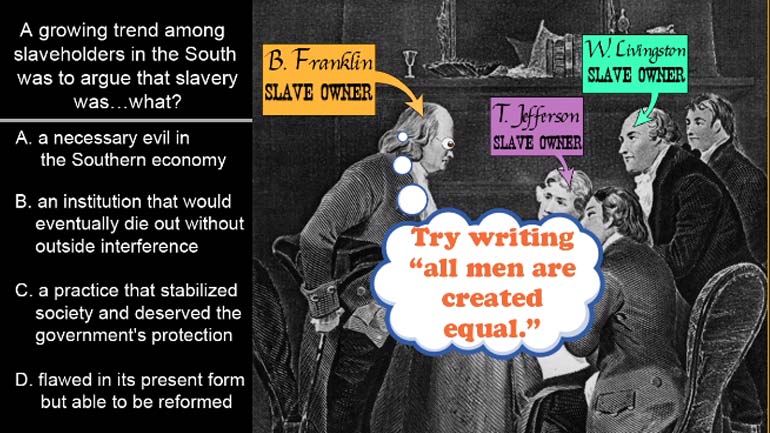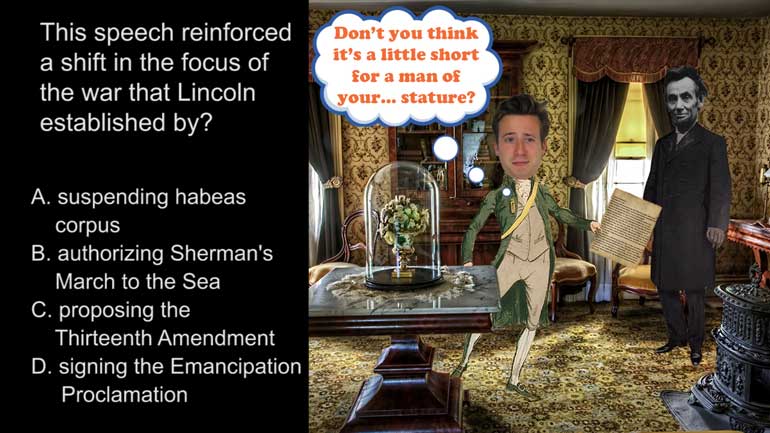ShmoopTube
Where Monty Python meets your 10th grade teacher.
Search Thousands of Shmoop Videos
A Distinctive Southern Identity Videos 2 videos
AP U.S. History Diagnostic 9. How did the depletion of farmland in the Southeast increase tensions over slavery?
AP U.S. History 1.2 Period 4: 1800-1848. A growing trend among slaveholders in the South was to argue that slavery was...what?
AP U.S. History 1.2 Period 4: 1800-1848 274 Views
Share It!
Description:
AP U.S. History 1.2 Period 4: 1800-1848. A growing trend among slaveholders in the South was to argue that slavery was...what?
Transcript
- 00:00
[ musical flourish ]
- 00:03
And here's your Shmoop du jour, brought to you by flawed logic,
- 00:06
arguments in need of a little touch-up.
- 00:08
All right, take a look at this excerpt.
- 00:10
No argument is necessary... [ mumbles ]
Full Transcript
- 00:13
All right, and the question:
- 00:14
A growing trend among slaveholders in the South
- 00:17
was to argue that slavery was...
- 00:20
What? And here are your potential answers.
- 00:23
[ mumbles ]
- 00:28
All right, well since slavery had been an accepted institution
- 00:30
in American culture from our earliest days...
- 00:34
Southern slaveholders had never really needed to justify its existence.
- 00:39
But once Northern abolitionists
- 00:41
started campaigning against slavery,
- 00:43
plantation owners were forced to come up with
- 00:45
ways to defend the horrible practice.
- 00:47
Let's see which of the answers best describes
- 00:50
the line of reasoning they used.
- 00:54
Was their argument that slavery was
- 00:56
A - a necessary evil in the Southern economy?
- 01:00
Well, few people in the South argued
- 01:01
that it was a necessary evil.
- 01:03
Really, they didn't even see it as being evil...
- 01:07
given the twisted racial ideology
- 01:09
they had about Africans being lesser in value than whites.
- 01:13
So it ain't A.
- 01:15
Did they believe that slavery was
- 01:17
B - an institution that would eventually
- 01:19
die out without outside interference?
- 01:21
Well, quite the contrary.
- 01:22
At this point, the Southern economy was so dependent
- 01:25
on the cotton industry that the entire system
- 01:27
would've fallen apart if plantation owners all of a sudden
- 01:29
had to pay their employees.
- 01:31
What a concept.
- 01:34
So they didn't see a problem with the institution at all.
- 01:36
And that eliminates B and D.
- 01:38
Which means their main argument was that slavery was C -
- 01:42
a practice that stabilized society and deserved
- 01:45
the government's protection.
- 01:46
In their desperation to legitimize
- 01:49
slavery as a necessary institution...
- 01:53
slaveholders concocted all sorts of arguments.
- 01:57
One of these arguments was that slavery was a stabilizing
- 01:59
factor for society and needed to be
- 02:01
protected by the government. Really.
- 02:03
We're not kidding. That makes C the right answer.
- 02:06
You know how it goes.
- 02:06
When your ears are full of cotton, well,
- 02:08
it's really hard to listen.
- 02:10
[ gasp ] [ how dare you ]
Related Videos
AP U.S. History Exam 2.45. The journey shown on the map was an example of...what?
AP U.S. History Exam 2.26. This speech reinforced a shift in the focus of the war that Lincoln established by...what?
What did the Spanish messengers bring with them to North America? Hint: you probably wouldn't be thrilled to get this for your next birthday.
AP U.S. History Diagnostic 24. How did the United States choose containment over the National Security Council Report in Latin America?
AP U.S. History Exam 2.25. In writing the Gettysburg Address, Lincoln was still working to win over Northern voters who believed that...what?






